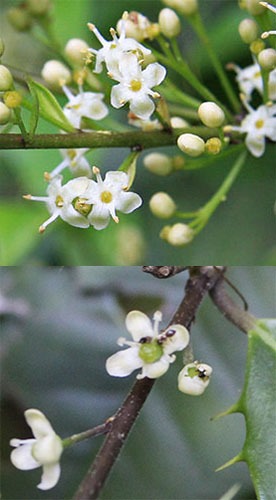
The American holly (Ilex opaca) is a native evergreen tree that grows throughout much of the eastern half of the country. In the wild, it can be found growing in rich, well-drained (but not super dry), slightly acidic soils. It prefers mostly sunny areas, but can be found growing as an understory tree in semi-open woods. It can also be grown as a native ornamental tree around homes, parks, and other developed areas.
American hollies have smooth grey bark which is often covered with a patchwork quilt of lichens. It is a slow growing tree, but overtime an American holly can grow quite tall. In natural settings, they often grow 30-60 feet tall with some individuals reaching almost 100 feet. However, in planted settings, they are often only 15-30 feet tall.
The growth form of an American holly is a very distinctive pyramid shape. If left to grow naturally, the lower limbs will go all the way to the ground; however in landscape settings, the lower limbs are sometimes trimmed off to allow the trunk to show. The leaves are thick and leathery with sharp, pointy projections.
All hollies, including the American holly, are dioecious meaning that some trees only produce male flowers and some trees only produce female flowers. Until the tree is 4-10 years old and starts flowering, there isn’t a good way to know whether it is a male or female tree. Both types of flowers are relatively small and white to greyish white. The male flowers have stamens with yellow pollen; while the female flowers have a round green ovary in the middle. Both male and female flowers produce nectar, but only the male flowers produce pollen.

In Kentucky, American hollies typically bloom in May and the flowers will last several weeks. Many different types of pollinators including honey bees, native bees, and butterflies are highly attracted to holly flowers. Depending on what else is blooming at the same time, honey bees will collect nectar from the female flowers and nectar and pollen from the male flowers.
After the flowers are fertilized, the female American holly trees will produce bright red, berry-like fruit. (Technically the fruit is a drupe, not a berry, but it looks like a berry and most people refer to the fruit as berries, unless you are a botanist and talking to other botanists.) The male trees do not produce fruit. The fruit will often hang onto the tree throughout most of the winter if it isn’t eaten first. Holly berries are poisonous to humans, but are an important source of food for many species of wildlife. At least 18 different species of birds, including cedar waxwings and cardinals, have been documented eating American holly berries.
The American holly is a great tree to consider if you are looking for an evergreen tree that is beneficial to pollinators and wildlife. They are fairly common in the horticulture trade and several varieties have been developed. In addition to the American holly tree, there are several other species of hollies native to North America. Some, like the possumhaw (Ilex decidua), are even deciduous. The other hollies native to North America are often a little harder to find in the horticulture trade, but some of the species are available, especially from some of the native plant nurseries or state forestry departments.
Many other holly species from other parts of the world can also be found in the horticulture trade. In general, as long as it isn’t a hybrid or one of the few invasive holly species, then most hollies are pretty good for pollinators and wildlife. So, if the American holly doesn’t fit your location or needs, you might want to consider another species of holly. However, don’t buy bare root hollies. They are much less likely to successfully transplant than balled and burlapped or potted specimens.

This article was part of Shannon’s original Kentucky Pollinators and Backyard Wildlife blog which evolved into the blog for Backyard Ecology.

Backyard Ecology: Exploring Nature in Your Backyard
Nature isn’t just “out there.” It’s all around us, including right outside our doors. Hi, my name is Shannon Trimboli, and I am the host of Backyard Ecology. I live in southcentral Kentucky and am a wildlife biologist, educator, author, beekeeper, and owner of a nursery specializing in plants for pollinators and wildlife conservation. I invite you to join me as we ignite our curiosity and natural wonder, explore our yards and communities, and improve our local pollinator and wildlife habitat. Learn more or subscribe to my email list at www.backyardecology.net.

Leave a Reply